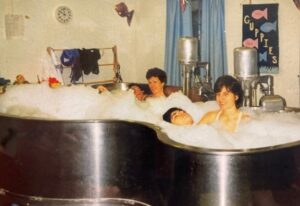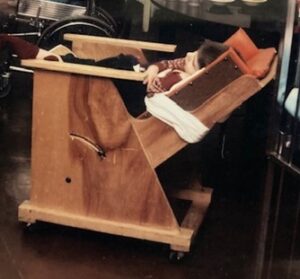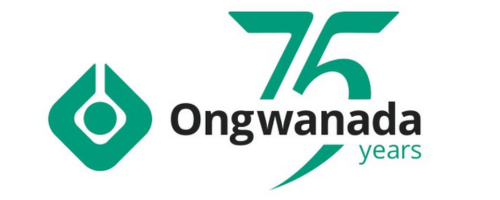Chapter One: KRC History
In 1974, Ongwanada first established a children’s rehabilitation clinic, having recognized that the young residents were capable of making achievements that previously had not been considered possible. The government of the time would not fund this service, and the Kinsmen Club of Kingston stepped in to fill the gap. Thus, the “KPRC”, or the Kinsmen Potential Rehabilitation Clinic, was officially opened in 1974, under the leadership of a young occupational therapist named Janet Henderson. Along with Janet, some of the early KRC staff included physiotherapist Bette Torrible and rehabilitation assistants Sharon Godard, Rose McDonnell, & Valerie Simpson. Val, who began working for the KPRC in 1977 and who is now only semi-retired, remembers this of the old days: “At Hopkins our goals were to help the children learn self-feeding and toileting, as well as gross motor and fine motor skills and sensory integration. Every Friday we would pile into an old school bus and go on a big outing, such as to the Toronto Zoo. In the summer we would spend a week at a sleep-over camp.”

Photo: Sharon Godard & Val Simpson in the Hubbard tank at Hopkins, with lots of bubbles!
Physiotherapist Bette Torrible was a huge proponent of hydrotherapy & this became a significant part of the KRC’s role. Originally, hydrotherapy took place in a Hubbard tank, which is a very large bathtub with jets that is often used in hospital burn units. Bette campaigned fiercely for including a proper hydrotherapy pool in the new Ongwanada Resource Centre, advocating for the many physical, psychological & social benefits of water therapy/play. Providing appropriate wheelchairs became a large focus of the department as well: because there was little equipment available at the time, the therapists were involved in developing mobility devices that met the unique needs of the people served. Val recalls the following: “Many of the children did not have wheelchairs–we just carried them, and when they got bigger sometimes the carpenter (Reg Beck) would help build something to suit them.”

Photo: a wooden “wheelchair” at Hopkins created by therapist-carpenter collaboration
Over the following decades there were other developments:
- A communication program was added in 1984, with a speech therapist & speech assistants
- The “P” was dropped out of KPRC in 1989
- As children supported by Ongwanada were integrated into public schools, KRC physiotherapists & occupational therapists provided support to the teachers and educational assistants. As people transitioned into adult day programs, this support continued
- Queen’s University rehabilitation students made the trek to the new Resource Centre to learn about pediatrics, developmental disabilities & hydrotherapy
Submitted by: Jen Sivilotti


